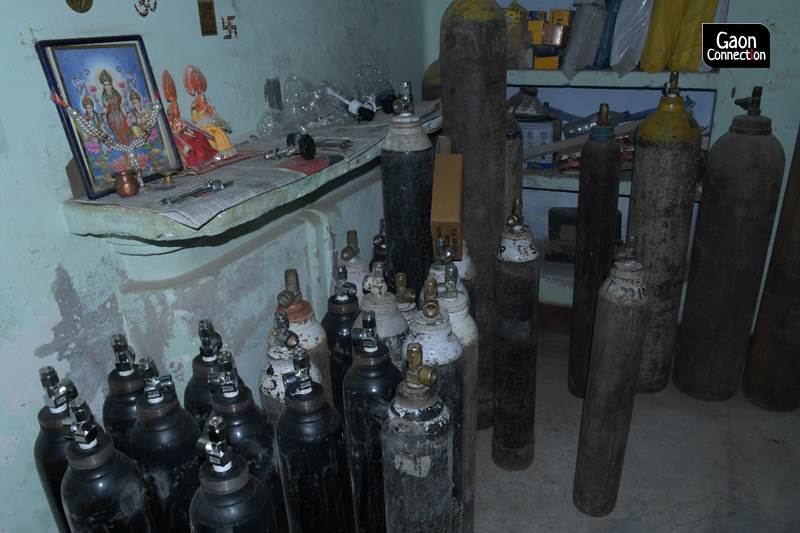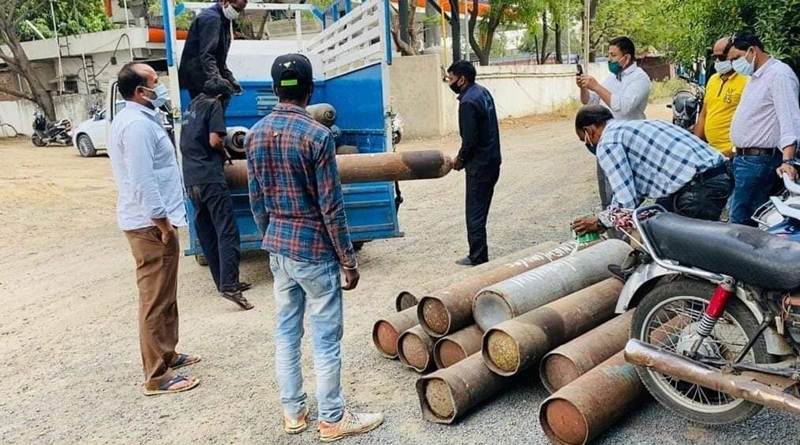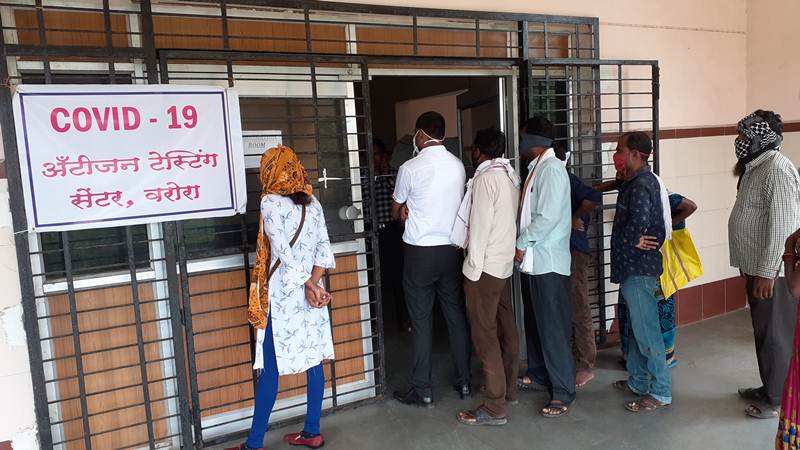Running out of breath as scramble for oxygen cylinders begins
India is in the grip of the second COVID19 wave recording 234,692 new cases in the last 24 hours. In COVID19 infections, about 10-15% patients require oxygen support. Amidst surging cases, an acute shortage of medical-grade oxygen cylinders is being felt leading to jacking up of prices. Rural India may face the heat soon, warn experts.


Almost every hour, there are news reports pouring in from different parts of the state, and the country that patients, their families, hospitals and medical staff are struggling to access oxygen cylinders. Photo by Mohit Shukla
Standing near his pickup truck, wearing an overused medical facemask, a driver waits as oxygen cylinders are loaded into his vehicle on a hot summer morning in Shahjahanpur, about 170 kilometres from Uttar Pradesh capital Lucknow.
For the last three days, he has been extremely busy — driving more than 300 kilometres every day — supplying oxygen cylinders to Lucknow, where coronavirus cases are rising fast, leading to high demand for oxygen cylinders. Among other things, the disease causes a drop in oxygen levels in the blood.
“During the past three days, I have transported about 30 oxygen cylinders and supplied them to private hospitals in Lucknow. A driver-friend of mine is doing the same,” the driver, a resident of Shahjahanpur, told Gaon Connection on condition of anonymity.
“Every day, I witness at least four to five trucks getting loaded with oxygen cylinders at a supplier’s godown in Shahjahanpur for supply to private hospitals in Lucknow. It is a mad rush, and I have never witnessed anything like this before,” he added.
Also Read: Ripple effect of COVID-19’s second wave in India being felt across the globe

Almost every hour, there are news reports pouring in from different parts of the state, and the country that patients, their families, hospitals and medical staff are struggling to access oxygen cylinders.
Yesterday, April 16, Prime Minister Narendra Modi reviewed the situation of medical-grade oxygen supply in the country. “Prime Minister suggested to increase oxygen production as per capacity of each plant. It was discussed that surplus stocks of oxygen supply in steel plants are being offered from medical use (sic),” noted the Prime Minister’s Office (PMO) press statement.

Meanwhile, latest news reports point out how diversion of oxygen from industrial units has brought several industrial activities to a grinding halt. Two days ago, Reliance Industries Limited’s (RIL) managing director Mukesh Ambani reportedly said the company was diverting oxygen produced at his refineries to help battle the second wave of the pandemic.
Last month, the public health department of Maharashtra, the state worst affected due to the virus, had directed oxygen manufacturers to divert 80 per cent of their stocks for medical use and retain the rest 20 per cent for industrial purposes. This 20 per cent may also now be diverted for medical emergencies.
India is in the grips of a massive second wave of COVID19 with 234,692 new corona cases reported in the last 24 hours and 1,341 deaths. Just 12 days back, on April 5, the country had reported over 100,000 cases a day. So far, 173,152 people have died due to COVID-19 related reasons in the country.
Usually, 20 out of every 100 COVID19 patients manifest the disease symptoms and three per cent of them are categorised as critical. About 10-15 per cent of patients may require oxygen.

Last year, an expert committee under the Union health ministry had advised daily monitoring of COVID-19 patients on oxygen support, and that only those with saturation levels below 94 per cent be put on oxygen support.
Oxygen cylinders at four times the price
Uttar Pradesh, India’s most populous state with over 200 million population, is also recording a steep rise in daily corona cases. The state recorded its highest single-day jump of 27,426 COVID19 cases and 103 deaths on April 16 with Lucknow recording 6,598 cases.
Also Read: How did India’s most populous state Uttar Pradesh lead the COVID-19 battle?
Like Shahjahanpur, Sitapur district, which is located about 90 km from Lucknow, is also supplying medical-grade oxygen cylinders to hospitals in Lucknow and other districts of Uttar Pradesh. Because of the high demand, there is a shortage and, hence, a predictable manifold increase in the price.
“Earlier, oxygen cylinders used to be supplied to Sitapur from Lucknow. Ever since this second wave has hit the state, the oxygen cylinder market is on fire,” a commercial oxygen supplier from Sitapur told Gaon Connection on condition of anonymity.

“Earlier a 110-120 litre pressure cylinder used to cost four hundred rupees, but now we ourselves are getting it for eight hundred. So, we are also selling it at four times the original price. I already have orders, but due to supply shortage, I am unable to meet the demand,” he added.
Meanwhile, about 150 km from Sitapur, in Unnao district, refilling of cylinders takes 15-20 hours, informed Manoj Sisodia, manager, Saraswati Medical College. This can seriously impact the availability of oxygen in case the number of cases soar, he said.
“There’s no shortage of oxygen cylinders in Unnao as of now. At present, there are one hundred and seventy nine patients in the COVID19 hospital. We have enough stock of oxygen now, but if the number of patients increases suddenly, the demand will be difficult to meet,” Sisodia told Gaon Connection.
He also informed that almost 2,000 COVID19 tests are being done in Unnao every day, out of which 800-900 samples are being sent to Lucknow for RT-PCR (Reverse transcription polymerase chain reaction) testing. “The lack of timely delivery of results leads to infected people not isolating on time, which can lead to a larger number of cases in the coming days,” he said.
Two days ago, on April 15, 123 persons tested positive for COVID19 in the district, taking the active cases to 578.
Also Read: COVID19 Update – 217,353 new corona cases in India; Delhi the worst-affected city
The situation is similar in Barabanki district neighbouring Lucknow, which is witnessing a surge in COVID19 cases and has 461 containment zones.
“At present, there is enough stock of oxygen in the district but seeing the pace at which COVID19 cases are rising, it is certain that there will be a shortage of oxygen cylinders in the coming days,” BKS Chauhan, Chief Medical Officer, Barabanki, told Gaon Connection.
Yesterday, Uttar Pradesh Chief Minister Yogi Adityanath issued directives to ensure sufficient number of ICU beds in districts with a high number of active COVID cases that include Lucknow, Prayagraj, Varanasi, Kanpur Nagar, Gorakhpur and Jhansi. In addition to this, he also directed uninterrupted supply of oxygen in corona hospitals and oxygen cylinders should be regularly replaced in all districts.
Meanwhile, the neighbouring state of Madhya Pradesh is witnessing similar issues. In the Satna district, the total coronavirus infections have risen to 4,723 and the supply of oxygen cylinders is erratic. “We used to order liquid oxygen from Nagpur but it is not able to supply it to us anymore. So we are now dependent on states like Haryana and Chhattisgarh for our supplies. It is from Satna that districts like Rewa and Panna get their supplies,” Tripurari Singh, manager of an oxygen refilling plant in Satna, told Gaon Connection.
“Earlier there used to be demand for 400 cylinder in a week but now it has increased to around 600 cylinders,” he added.
Keeping in mind the shortage of oxygen cylinders, the central government intends to import 50,000 metric tonnes of medical oxygen. The Ministry of Health and Family Welfare has been directed by the Centre to come up with a tender for the import. Industry experts opine that India has the capacity to produce more than 7,000 metric tonnes of medical oxygen at most and capacity cannot be increased on such a short notice. Hence, import becomes critical.
Written by Pratyaksh Srivastava with inputs from Mohit Shukla in Sitapur, Ramji Mishra in Shahjahanpur, Sumit Yadav in Unnao, Virendra Singh in Barabanki and Sachin Tulsa Tripathi in Satna.

